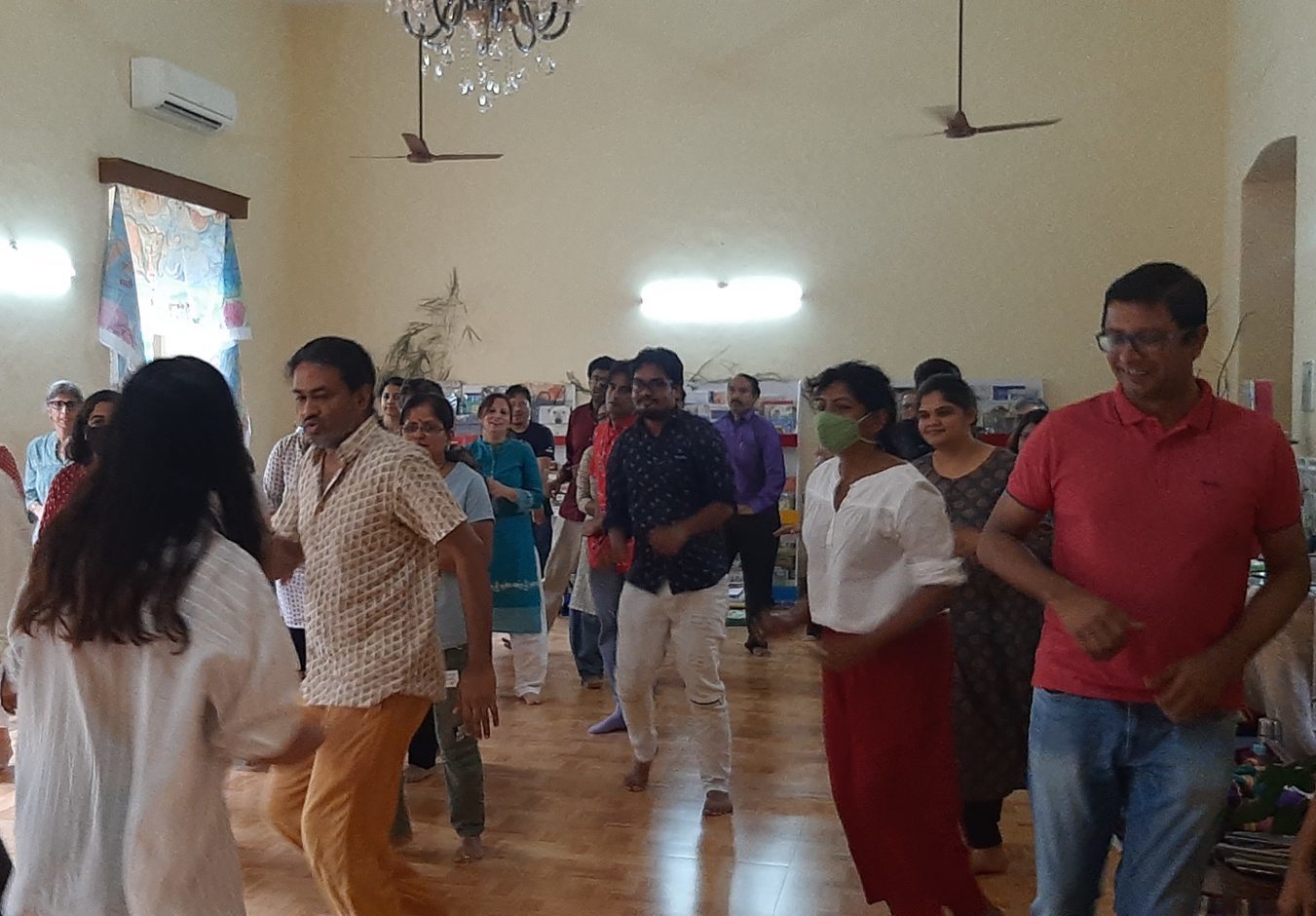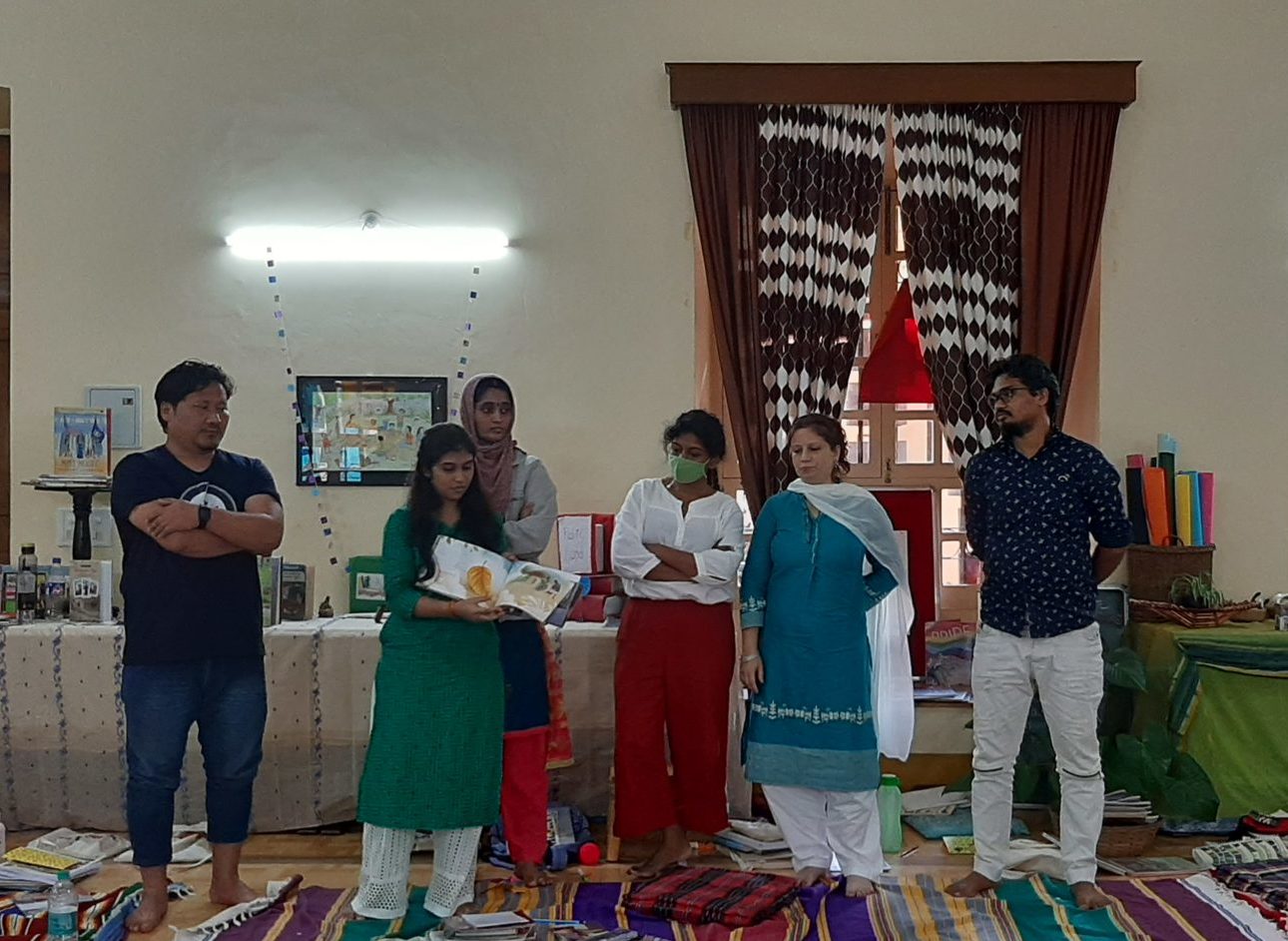Written by Joeanna Rebello Fernandes, LEC 2021
I’d imagined a quiet week. The LEC was a course on library education, and the libraries I’d known were silent as churches (with the occasional sermon thrown in). The first in-person contact would be low-decibel too, I thought—high-impact, but muted.
There was serious pedagogy to be discussed—reviews of best library practices; questions contemplating the meaning and objectives of reading; ruminations on how to curate all-embracing book collections; brainstorms to tackle the challenges of a modern library. All of this was to be woven into a tight 6-day schedule that would also include deep-see journaling, critical reading, and quiet meditation.
The first contact of the LEC course turned out to be everything I had expected.
And a few things I hadn’t.
What I did not see coming was the singing. Or the dancing. Or the play-acting. Or the needlework. I did not expect to be drafted into a performance artwork, enacting with my group the common theme of a book collection (the sadness of leaving home and the joy of homecoming). I did not see myself corkscrewing around the conference hall, doing the Twist. And I certainly hadn’t imagined racing around the narrow corridors of the labyrinthine Bookworm Library, playing half a dozen games in under two hours.
 Lacing through the taught fabric of the LEC Contacts library education programme were bright, pulsing strands of fun and games that threw me back into childhood. Every day was leavened by some form of play. But it wasn’t play in and of itself. Each game or creative exercise was thoughtfully designed to draw us into a deeper engagement with the library, and with the books it held.
Lacing through the taught fabric of the LEC Contacts library education programme were bright, pulsing strands of fun and games that threw me back into childhood. Every day was leavened by some form of play. But it wasn’t play in and of itself. Each game or creative exercise was thoughtfully designed to draw us into a deeper engagement with the library, and with the books it held.
The game of “musical books”, for example, had us circling a set of picture books placed on the floor of one of the library’s many rooms. When the music stopped we were required to pick up the book in front of us, and study it for a particular prompt the coordinator called out. This was definitely not some random, robotic perambulation. The game’s intent was to observe and absorb the often overlooked components of a book: the name/s of its creator/s; the publisher; the ISBN number. Knowing the publisher of a book I found interesting would draw me instinctively to other books in its stable. The year and place of publishing would locate the book within a certain temporal and spatial context. “Ah, somebody in this place and time saw and thought about the world this way.”
A game of snakes and ladders in another room had us acting out a series of challenges for every snake we slid down. (Truly, In Other Rooms, Other Wonders.) Each challenge was drawn out of a bag of paper chits, calling us to enact a theme from a book set aside for the purpose. We could use any of the props helpfully laid out, from long blades of coconut leaves, to colourful dupattas. This time, we were nudged to burrow beneath the topsoil of the story, looking for underlying meanings and inferences.
Perhaps of all the games, my favourite was the one played in the library’s corridors. It was a team game of crosses and knots that had each member of a team pull out a book from a covered basket. Then, looking at its genre label and recalling Bookworm’s colour code of classification, we hared off around that book-hive, searching for the correct shelf to which to return the book. (As with people, every book has its place in the world.) The fastest one back to the whiteboard chalked in a cross or a knot, hoping to rout the other team.
Squeals and laughter echoed through the building as game after game was played out by participants who had long since slipped out of their too-tight adult skins.
Most of us already knew about these things—classification, and copyright pages, and how to parse and conjugate letters and art. What I hadn’t thought about though, was how to convey it to children in ways that would make it fun, and make it stick. In fact the longer I mulled over it, the more clearly I could see what games in a library could do to achieve these, and other ends.
At the LEC contact, Play had worn down my own walls of resistance and created a space for the child in me to emerge and participate in the programme with unfettered frankness. With each game I played, each silly song I sung, the child-me grew more and more at ease. I found myself both, receiving and sharing ideas and emotions in what I saw was a safe and encouraging space. A space where opinions could be shared, applauded, and even corrected, without fear of judgment or reprisal.
Transposed to the library, wouldn’t a child’s engagement with books—both, the reading and discussion of them—be more alert, enthusiastic, and unrestrained when mediated through play? The adrenaline rush, the serotonin kick that accompanies fun and laughter would perhaps lead them to new and improved library experiences. In addition, I imagined the heady peak triggered by a treasure hunt or a lively guessing game sliding naturally into a calm and quiet clearing, creating conditions ideal for reflection and sharing.
The idea spoke to me again two weeks after I’d returned home from the first contact session. I’d loaned the picture book Ahmed and the Feather Girl to a friend’s son, a boy who was happiest in imaginary worlds of his own making. Returning it a few days later, my friend said, “He loved the story. . . but what he loved best was discovering the feather you’d slipped inside.”
I remember picking up the brown hawk feather in a forest and nesting it in the book. I hadn’t thought ahead to its chance discovery by a 7-year-old, months later. Now, I thrilled to think about the journey it may have set him on, further down the road from the story. ‘How far did he fly? Where did he go?’ I wondered.
It made me realize there were so many ways to animate a book, both inside and outside the library (like slipping a thought-prompt, a riddle, a drawing, or an object between the pages to be discovered at home).
The harder I stared, the more doorways opened up through discovery and play, for a child to step joyfully into the library and its stories. A book cover was just one of them.

